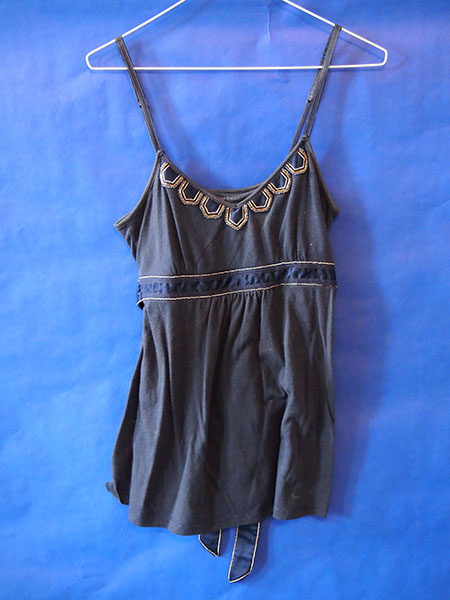![]() body | color | collections | commodity | cube | document | fabric | fetish | gender | glass | home | identity | living | machine | metal | minimal | mobility | narrative | olfactory | organic |
body | color | collections | commodity | cube | document | fabric | fetish | gender | glass | home | identity | living | machine | metal | minimal | mobility | narrative | olfactory | organic |
![]() pain | paper | plastic | plugs | power | protective | rectangular | ritual | round | sound | souvenir | spiritual | style | text-based | time | tool | touch | uniform | value | visual | warm | wood
pain | paper | plastic | plugs | power | protective | rectangular | ritual | round | sound | souvenir | spiritual | style | text-based | time | tool | touch | uniform | value | visual | warm | wood
| Clothing: Navy Tank Top with Built in Bra and Bead Decoration on the Front | |||
Narrative: American Eagle Outfitters Navy blue tank top with built in bra and bead decoration on the front; Small; Made in Vietnam A Christmas present from my sister in 2008. Made of spandex fibers are produced in four different ways: melt extrusion, reaction spinning, solution dry spinning, and solution wet spinning. The solution dry spinning method is used to produce over 94.5% of the world's spandex fibers. The first step is to produce the prepolymer. This is done by mixing a macroglycol with a diisocyanate monomer. The two compounds are mixed in a reaction vessel to produce a prepolymer. A typical ratio of glycol to diisocyanate is 1:2. The prepolymer is further reacted with an equal amount of diamine. This reaction is known as chain extension reaction. The resulting solution is diluted with a solvent to produce the spinning solution. The solvent helps make the solution thinner and more easily handled, and then it can be pumped into the fiber production cell. The spinning solution is pumped into a cylindrical spinning cell where it is cured and converted into fibers. After nearly 15 years of research first polyester fiber was developed in England known as Terylene in 1941. In 1946 American du Pont de Nemours and Co. purchased right to manufacture polyester in the United States nearly reversing fiber rations in the U.S. in the 1950’s. It’s development and usage in World War II brought the use of synthetic fibers during wartime up 10%. Derived from coal, air, water, and petroleum. Principle ingredient in manufacturing is ethylene (from petroleum). Fibers are formed from a chemical reaction between acid and alcohol. The structure of the molecule created repeats throughout the fiber length. Basic forms of manufacturing are filament, staple, tow, and fiberfill. Does not absorb moisture but does absorb oil; perfect for application of water, soil, fire resistant finishes. Does not stretch out of shape , does not get damaged by mildew. The cotton process demands cultivators rip out weeds and grass that may compete with the cotton. Land is plowed under and soil is broken up and formed into rows. Cottonseed is planted. The boll matures in a period that ranges from 55 to 80 days. Ten weeks after flowers first appeared, fibers split the boll apart, and cotton pushes forth. The process includes seeding, picking, ginning, and baling. Samples are taken from the bales to determine the quality of the cotton. At this point the cotton plant is defoliated if it is to be machine harvested. Defoliation is often accomplished by spraying the plant with a chemical. At a mill the bale is broken, the fibers are opened by a comb-like device, mixed together, and cleaned. The cleaned cotton fibers are called laps. The laps are fed into a carding machine that separates the fibers. Further cleaning, combing, and sorting readies the fibers for processing into thread. Power generation and supply; Cotton farming; Truck transportation; Oil and gas extraction; Other basic organic chemical manufacturing; Artificial and synthetic fibers and filaments manufacturing; Hosiery and sock mills; Petroleum refineries; Iron and steel mills; Plastics material and resin manufacturing. Water withdraw includes: Cotton farming; Grain farming; Artificial and synthetic fibers and filaments manufacturing; Hosiery and sock mills; Power generation and supply; Fiber, yarn, and thread mills; Other basic organic chemical manufacturing; Paperboard mills; Paint and coating manufacturing; Synthetic dye and pigment manufacturing. |
 |
||
![]()
